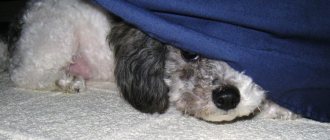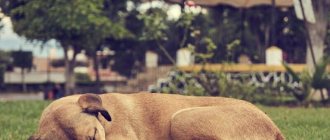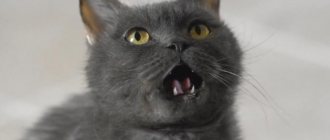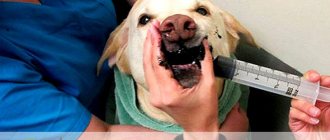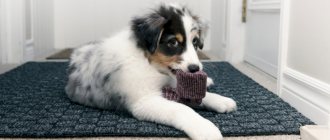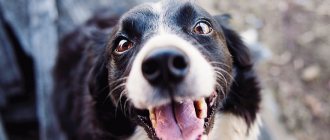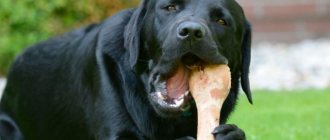Whether you're stopping to take a quick break on a park bench or relaxing while watching TV on your favorite couch, your dog will most likely be by your side. Most dogs prefer to sit or lie on their owner's legs.
If you don't get up to go somewhere, the dog will eventually move on to lying down and sleeping on your legs.
While this behavior isn't particularly bad, it can be a little annoying for some owners. This is especially true if your dog has a nice, expensive bed, but instead chooses to lie on the floor at your feet.
Whether you love it or hate it, it's good to understand why your dog does it.
Dog instincts
Dogs are pack animals. Even if your pampered pup has never spent time in the wild, he still has these behaviors. Often the process of sitting on their feet is simply a remnant of the DNA of their ancestors.
In the wild, dogs live in packs. They do this to protect themselves and hunt together to survive. When they sleep or rest, they huddle together. The leader of the pack gets the most comfortable place, while the other dogs lie nearby to keep warm.
The dog wants to make his “bed” softer
Professor Stanley Coren, who conducts neuropsychological research on the behavioral activity of dogs, has established a relationship between the degree of unevenness of the surface and the number of turns the dog makes before lying down. In the experiment, the behavior of sixty-two dogs was observed as they went to sleep on surfaces with different types of relief. The conclusion is clear - the longer the dog stomps on the bed, the more unevenness there is on the surface.
It turns out that the main meaning of the animal's circling is akin to shaking a sheet. These actions have one goal - to make the place where you spend the night comfortable for sleeping.
The distant ancestors of canines living in nature and their current wild relatives crushed the grass in this way and made the bed comfortable. At the same time, they scared away stinging living creatures - snakes, insects - from the place chosen for the bed.
Safety
As the leader of your family, you wear many hats in your dog's eyes. One of the most important roles you play for a dog is that of protector. If your puppy is insecure about something, he will turn to you for protection.
This often happens with more submissive dogs. However, even the largest and most intimidating breed will go to its owner if it feels in danger.
Dogs may become anxious around new people, loud noises, and anything else they are not used to. They will sit or lie at your feet for some comfort. Sometimes your touch is enough to make your dog feel safe.
If your dog falls asleep on your feet, pay attention to how he sleeps. If they sleep on their side, with your warm feet underneath them, they feel completely protected.
This position exposes the belly, which is a big risk in the wild. Lying on their side shows you that they trust you with their safety.
What to do
Now that we've narrowed down the reasons why dogs walk and won't lie down, you'll want to know if there's a way to reduce this behavior in your pet.
- Get a diagnosis and prescribe treatment
- Pay attention to your dog
- Spay or neuter your dog
- Play games with your dog
- Try to reduce stress
- Comfort your best friend
Between you and your trusted veterinarian, there are many methods that can be used to reduce your dog's stimulation.
Attachment
Your dog may sit, lie or sleep at your feet simply because he loves you. She wants to feel your touch, hear your breath and smell you.
If you've been gone all day, your dog may be acting this way because he missed you and didn't want you to ever leave again.
Some dogs also show signs of affection to comfort you. Dogs are intelligent creatures that can pick up on your emotions quite easily.
If you're crying, sick, or showing signs of stress, your dog will be right there to calm you down.
This is completely normal behavior. In fact, if your dog sits at your feet just to show you that he loves you, it means you are doing a great job as an owner.
Your dog is grateful for what you do for him, loves being around you, and doesn't want you to leave his side.
Ways to increase your four-legged friend's appetite
Man's four-legged friends, like man himself, sometimes become capricious and refuse to eat boring food. A few tips will help you get everything back to normal:
- Sometimes limiting the number of treats is enough to increase a dog's appetite. As a rule, they are given to the dog between meals;
- reluctance to eat may be a consequence of lack of physical activity. Regular exercise stimulates appetite;
- Often, refusal to eat is the result of a lack of discipline. If the dog is spoiled and is used to getting food whenever it wants, the owners should think about creating a schedule for dispensing food. The bowl of food is set out for 15 minutes, and after this time it is hidden, even if the food is not touched. Gradually, the dog will learn: if he has not eaten, he will have to starve until the next food distribution;
- in some cases, the problem is solved by reducing the portion by 10%.
There are a few tricks to increase your dog's appetite.
For your information! You can increase your four-legged friend's appetite by adding special sauces for seasoning dog food.
How can I stop sitting on my feet?
Generally, a dog's habit of sitting on its feet is not a cause for concern. Most owners like this.
This is a great time to bond with your dog and show him loving affection.
However, if you don't want your dog to be constantly underfoot during the day, there are a few things you can do.
Chances are you already have positive reinforcement. If you've ever pet your dog or scratched their back while they were sitting at your feet, you've already shown them that this is normal.
If you want her to stop sitting on your feet, you need to stop expressing your affection back.
Never yell or kick your dog while he is sitting at your feet. The best way to stop this behavior is to encourage them to lie down in their place.
Create a cozy environment and shower them with praise every time they get into bed. The dog will appreciate the rewards and will try to earn them.
Authors: Doctor of Veterinary Sciences Kozlov N.A.
Polyansky R.K.
This article will discuss pathologies in the cervical spine in domestic animals, which cause varying degrees of neurological disorders, often the leading symptom being pain in the neck.
These problems are less common than, for example, surgical diseases of the musculoskeletal system, but they do exist and must be correctly and timely diagnosed and treated professionally. After all, the success of further treatment depends on a quickly established diagnosis. The problem is that most neurological pathologies in the cervical spine have similar clinical signs, and there are quite a lot of such pathologies. Also, in the initial stages, neurological disorders manifest themselves as lameness, which is typical for diseases of the musculoskeletal system. All this prevents the timely provision of assistance to a sick animal.
Etiology. Pathologies of the cervical spine and spinal cord are divided into:
- Degenerative (Wobbler syndrome), damage to the joints of the spine, herniated disc or discopathy;
- Developmental anomalies and genetic predisposition (atlanto-axial instability, syringo-, hydromyelia, atlanto-occipital dysplasia, arachnoid cysts, vertebral deformity, spondylosis deformans;
- Metabolic and feeding disorders (secondary hyperparathyroidism), vitamin A hypervitaminosis in cats;
- Neoplasia (tumors of various nature and localization);
- Idiopathic pathologies;
- Inflammation and infection (discospondylitis, epidural empyema);
- Traumatic (fractures, spondylolisthesis, disc damage, gunshot wounds);
- Toxic (botulism, tetanus);
- Vascular disorders (fibrocartilaginous embolism, hematoma in the spinal canal, necrosis of epidural tissue, myelomalacia).
Clinical signs. They are very diverse and depend on the degree of involvement of nervous structures in the pathological process. The only sign that all these pathologies have in common is the presence of a neurological deficit in the thoracic and pelvic limbs or one of them. In the acute course of the process, the development of tetraplegia and tetraparesis (paresis of all four limbs) is possible. Also, the following signs can most often be observed (one or more of the above symptoms are noted simultaneously):
- the animal is lame on one or both thoracic limbs,
- the animal is constrained, less active,
- holds his head in a forced position - head down,
- impaired coordination of voluntary movement and balance in a standing position (ataxia),
- moves carefully
- A painful reaction is often expressed when examining the animal, usually when the neck is extended.
- owners complain of a changed position of the limb and a change in gait. In this case, the limb(s) are supported on the volar (front surface of the paw) surface.
All these clinical signs should prompt the veterinarian to think about a possible pathology in the cervical spine and conduct additional studies to confirm the diagnosis.
Diagnostics. It is impossible to make an accurate diagnosis of a neurological problem in the cervical spine by collecting only anamnesis and conducting a neurological examination of the animal. After a neurological examination, it is only possible to assume the localization of the process. A very small number of neurological pathologies of the neck can be diagnosed using an x-ray. Therefore, more modern and informative diagnostic methods are required:
- Myelography,
- CT (computed tomography), CT myelography,
- MRI (magnetic resonance imaging).
These diagnostic methods allow you to accurately establish a diagnosis and, depending on the pathology, select the necessary treatment regimen:
- conservative treatment
- surgical intervention.
Wobbler syndrome.
Wobbler syndrome (English: Cervical Vertebral Insability (CVI) or cervical spondylopathy) is a complex of neurological manifestations (shaky gait, weakening of voluntary movements of the limbs, neck bent when walking, etc.) resulting from compression of the spinal cord in the cervical region. Compression occurs when there is instability (instability) or disruption of the structure of the cervical vertebrae, most often the latter.
The word “wobbler” itself is translated from English (['w?bl]) as “to walk staggering; wobble". The incidence of this syndrome is highest in dogs of large breeds : Great Danes, Dobermans, and to some extent in Rottweilers, retrievers, Belgian and German shepherds, wolfhounds and huskies.
MRI of a 5-year-old retriever, Wobbler's syndrome, discopathy at levels C5-C6, C6-C7.
Atlanto-axial instability.
Atlanto-axial instability (syn. atlanto-axial subluxation (subluxation), dislocation (luxation)) - is excessive mobility in the atlanto-axial joint, between the first (C1) and second (C2) cervical vertebrae, which leads to compression of the spinal cord in this area and, as a result, manifests itself in varying degrees of neurological deficit. Atlantoaxial instability is one of the anomalies (malformations) of the spinal column (Sharp NJH, Wheeler SJ 2005). This pathology is typical for dwarf dog breeds (DeLachunta.2009), but it also occurs in large breeds.
Atlanto - axial instability in the York Terrier
Stringo(hydro-)myelia.
Syringo (hydro-) myelia (from the Greek syrinx, genitive case syringos - tube, canal and myelos - spinal cord) is a chronic progressive disease of the nervous system, characterized by the formation of cavities in the spinal cord filled with cerebrospinal fluid, sometimes the proliferation of neuroglia, sensitivity disorders and motor functions, trophic disorders, pain upon touching or flexion/extension of the neck. Sometimes a symptom is increased sensitivity of the skin in the facial area of the skull.
Toy terrier with syringohydromyelmy. Turning the head to the right, pain in the neck.
CT scan of Syringohydromyelia at the C2-C3 level. Hydrocephalus is often observed in such animals at the same time.
Discospondylitis.
Discospondylitis is an infectious disease in which the vertebral bodies and intervertebral discs are involved. The inflammatory process is localized in the intervertebral space and can affect more than 2 vertebral bodies, which is extremely rare in an oncological process, in which, as a rule, only the 1st vertebral body is affected.
MRI of Rottweiler, age – 5 years, discospondylitis – Th 7, Th8.
The cause of discospondylitis in dogs may be a breed predisposition (German and Bernese shepherds), an infectious process (brucellosis, aspergillosis), a foreign body (grass seeds, plant needles and thorns, wood chips) (Fossum TW, 2007), postoperative infection (non-sterile suture material ), as well as the immunosuppressive state of the body.
The cause of discospondylitis in dogs may be a breed predisposition (German and Bernese shepherds), an infectious process (brucellosis, aspergillosis), a foreign body (grass seeds, plant needles and thorns, wood chips) (Fossum TW, 2007), postoperative infection (non-sterile suture material ), as well as the immunosuppressive state of the body.
Discopathies of the cervical spine.
Intervertebral disc herniation is one of the most common neurological diseases (Sotnikov V.V. 2008) in the daily practice of a veterinarian, and at the same time, the most common disease among spinal pathologies in dogs (Jeffery ND, 1995, Sharp and Wheeler, 2005). As a rule, animals aged 2-6 years are affected. Most of them are chondrodystrophic breeds, although there may be exceptions - dachshunds, Pekingese, spaniels. The leading clinical sign is pain in the neck. In such animals, o syndromes (associated with compression of the nerve root) - the thoracic limb lightly touches the floor surface, often only with the tips of the claws.
Injuries.
- Vertebral fractures.
- Spondylolisthesis (from the Greek spondylos - vertebra and olisthesis - sliding) is a disease of the spine, which is manifested by displacement of the vertebra as a result of spondylolysis (congenital non-fusion of the vertebral arch with its body), as well as degenerative changes in the intervertebral disc or as a result of injury.
Fibrous-cartilaginous embolism.
This disease refers to acute ischemia of the spinal cord caused by blockage of arterioles (the smallest arteries) by fibrocartilaginous material (nucleus pulposus of the disc) (Hoerlein BF, 1971). The cause may be injury or “age-related” changes in the intervertebral discs. Symptoms: unilateral or, much less frequently, bilateral paralysis quickly appears, absence of pain in the spinal column (as opposed to a herniated disc), usually followed by a gradual improvement in symptoms without progression of pathology. In general, the pathology is characterized by lateralization of symptoms (either the right or left side is affected). Over time, in most cases, no deterioration is observed. Foreign authors describe cases of FCE with pain syndrome, but such animals, as a rule, died within 2 hours. (Jeffery ND, 1995) This pathology is more common in the cervical spine. It is possible to diagnose the pathology by secondary changes on MRI (phenomena of spinal cord edema in the area of the FCE) and the characteristic clinical picture, but this cannot be established in all cases.
Hematoma in the spinal canal.
A spinal hematoma is a limited accumulation of spilled blood between the membranes of the spinal cord or in it itself, which can lead to its compression.
Hematoma occurs as a result of spinal trauma, an abnormality of a blood vessel (arteriovenous shunt), or bleeding in animals that suffer from bleeding disorders or pathologies of the endocrine system (diabetes).
Literature.
- Denny H. Orthopedics of dogs and cats - M.: Aquarium, 2004
- Sotnikov V.V. Diagnosis and surgical treatment of discopathy of the thoracolumbar spine in dogs. // Abstract of dissertation. candidate of veterinary sciences. M.: 2008.
- deLahunta A, Glass E. Veterinary Neuroanatomy and Clinical Neurology - WB Saunders, 2009
- Jeffery ND Handbook of Small Animal Spinal Surgery, - WB Saunders, 1995
- Fossum TW Small Animal Surgery - Mosby, 2007
- Hoerlein BF Canine neurology. —WB Saunders, 1971
- Sharp NJH, Wheeler SJ Small Animal Spinal Disorders. — Elsevier, 2005.
Here are some common sleeping positions.
The dog sleeps curled up in a ball
This is a position you will see frequently throughout your dog's life. Her paws are tucked under her body, and her tail is curved towards her muzzle.
In fact, they are tightly connected. This position may indicate that the dog is cold or that something is a little bothering him. The position protects their body.
The dog sleeps on its side
As mentioned earlier, this is exactly the position you want to see. Your dog will lie on his side, exposing his belly. This shows that your dog is trusting and carefree. They can sleep without worrying about anything.
Dog sleeps on his back
Also affectionately called “Crazy Legs,” this pose can be a little funny to watch. Your dog will lie on his back with his legs elevated. This is a submissive position because they leave their entire body exposed.
If your dog does this, it means that he is generally feeling calm, comfortable and safe.
Sleeps on his back with his paws pressed to his chest
Although this position is very similar to the previous one, the biggest difference is their front paws. In this position, the paws are pressed to the chest.
This usually means your dog is very tired and doesn't want to be disturbed. This may also indicate that they are feeling a little hot. The position allows them to cool down easily.
Star pose
In this position, your dog's head and belly are on the floor. Their four legs are then spread, giving the appearance that they are flying. Young puppies and energetic dogs do this because it is very easy to wake up and start playing again.
Half-bent posture
In the crouched position, your dog's paw is tucked under his body. However, she did not curl up into a ball. Dogs in this position usually do not sleep much because the muscles cannot relax properly.
Dangerous signs of lethargy in a dog
Overheat
Sunstroke is a common cause of ill health in dogs. In hot weather, make sure that dogs do not stay in the sun for long periods of time. Wet your dog's fur with water. If the dog has lost consciousness, try to reduce its body temperature by taking it to the shade and moistening its nose, paw pads, belly and ears with water. Then take her to the vet immediately.
Severe moisture loss
If you are going for a walk in hot weather, be sure to bring water for your dog. Dehydration of the body is very dangerous, it leads to a decrease in heart rate, saliva in this state becomes sticky and thick.
Hypothermia
Many dogs, especially short-haired ones, do not tolerate low temperatures well. You shouldn't go for a walk when it's freezing outside. If your dog is severely hypothermic, he may experience convulsions. Forget about your pet, buy him warm overalls and boots.
